Diplomatic Bluebook 2017
Chapter 2
Japan's Foreign Policy that Takes a Panoramic Perspective of the World Map
1.United States
(1) Situation of the U.S.
A Politics
The 2016 presidential election became a bruising battle in both the primary elections and the general election due to the diverse candidates, including candidates from outside the mainstream of each party. The large field of candidates including 17 major candidates for the Republican Party and three for the Democratic Party had their first battle in the primary election on February 1.
In the primary elections held sequentially in each state until the middle of June, Republican Party candidate Trump, a businessman, quickly moved ahead of the other candidates and early in May he secured the nomination. On the other hand, on the Democratic Party side, candidate Bernie Sanders, a senator who described himself as a democratic socialist, continued to doggedly fight with candidate Hillary Clinton, who had been expected to win easily, and his number of delegates, who are allocated based on the results of the primaries in each state, kept up with candidate Clinton. However, the majority of the super delegates who are selected mainly from state party officials, regardless of the results of the primaries, supported candidate Clinton, and she secured the nomination in early June.
The national party conventions that formally nominate the candidates for president and vice-president of each party were held from July 18 to July 21 in Cleveland, Ohio by the Republican Party and from July 25 to July 28 in Philadelphia, Pennsylvania by the Democratic Party. Candidate Clinton and candidate Trump respectively nominated Virginia Senator Tim Kaine and Indiana Governor Mike Pence to be their running mates immediately before their respective party conventions, and the presidential and vice-presidential candidates both won the candidate nominations formally at their party conventions.
Subsequently, during the period until the general vote by U.S. citizens on November 8, a bruising election battle took place, including debates by the candidates of both parties (thrice by the presidential candidates and once by the vice-presidential candidates,) and campaigning throughout the U.S. Candidate Clinton was thought to have advantages in terms of political experience, election funds, etc. and the major media outlets also said that candidate Clinton was in a stronger position right until the end of the campaign. However in the end, candidate Trump gathered support, including from independents, by drawing on the deep anger, dissatisfaction and anxiety of the citizens regarding the entrenched present situation and consistently claiming he would bring about a transformation to society and make America great again.
Regarding the states each candidate won, candidate Trump won in 30 states and a part of Maine, and candidate Clinton won in 19 states and a part of Maine as well as in Washington D.C. Candidate Trump won approximately 46% of the nationwide vote whereas candidate Clinton won approximately 48% but candidate Trump won the election by securing the presidential electors by the large margin of 306 to 232 because he was victorious in the swing states, including the so-called Rust Belt states.
In the Federal congressional elections held at the same time as the presidential election, the Democratic Party increased its number of seats in both the Senate and the House of Representatives but the Republican Party maintained its majorities, ending the situation in which party of the president and the majority parties in congress were different.
President Trump, who was inaugurated on January 20, 2017, had made clear during the election period that he would change the policies of the Obama administration, and he is proceeding with appointing Cabinet members and government officials in line with that assertion. On February 28 he gave his first speech to a Joint Session of Congress, in which he emphasized his determination to strengthen the economy through the repeal of Obamacare, tax system reform, infrastructure investment, regulatory reform, etc., to expand the defense budget, and to reform border control systems and so on in order to make America great again. Now the focus is on whether the president can cooperate with the new Congress to realize the various policies he proposed during the election in a form that meets the expectations of the citizens.
B Economy
(A) Current economic situation
The U.S. economy continued to recover gradually throughout 2016. The real GDP (revised value) of the October-December quarter grew at an annualized rate of 1.9% from the previous quarter. The unemployment rate continued to improve to reach 4.8% in January 2017. The U.S. economy is expected to follow the recovery path; however, it is necessary to take note of the trends and effects of policies going forward.
(B) Economic policy
In the Joint Session of Congress speech given at the end of February 2017, President Trump noted individual policies related to the economy including employment creation, tax system reform, medical insurance system reform, and infrastructure investment. He touched on regulatory reform, in particular the reduction of income and corporate tax rates, repeal of the Patient Protection and Affordable Care Act (“Obamacare”) and construction of a better medical insurance system, increase in the budget for domestic infrastructure construction, etc. while, regarding employment creation in particular, he put forth Buy American (purchasing U.S. products) and Hire American (promoting the employment of U.S. citizens) as major principles, and stated that since his inauguration multiple private companies had announced large-scale investment and employment expansion. On the other hand, regarding trade policy, he emphasized his withdrawal from the TPP was a good outcome, and asserted that free trade should be fair.
With regard to financial policy, the Federal Reserve Board (FRB) has been engaged in quantitative easing thrice since 2008; however, it decided to discontinue that at the Federal Open Market Committee (FOMC) meeting in October 2014, and discontinued it at the end of the same month. With the 2007 sub-prime loan issue as a turning point, the U.S. had maintained a zero-interest policy for seven years since 2008 with its target level of the federal fund rate at 0% - 0.25%, where the target range of the official rate had been lowered sequentially. However, at the FOMC meeting in December 2015, they decided to increase the target level for the first time in nine years since June 2006. Subsequently, at the FOMC meeting in December 2016, the target level was raised again, and as of February 2017 the target level of the federal fund rate was between 0.50% and 0.75%.
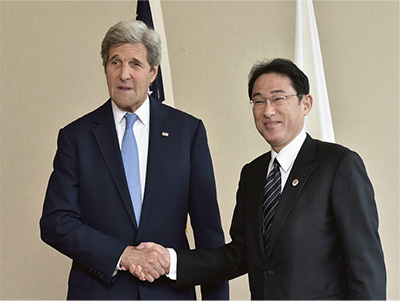 Foreign Minister Kishida shaking hands with U.S. Secretary of State Kerry at the Japan-U.S. Foreign Ministers' Meeting (April 11, Hiroshima Prefecture)
Foreign Minister Kishida shaking hands with U.S. Secretary of State Kerry at the Japan-U.S. Foreign Ministers' Meeting (April 11, Hiroshima Prefecture)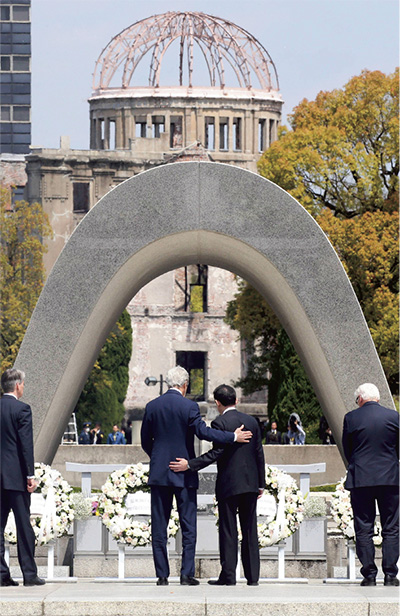 Foreign Minister Kishida visiting the Peace Memorial Park accompanied by U.S. Secretary of State Kerry (April 11, Hiroshima Prefecture; Photo: Sankei Shimbun)
Foreign Minister Kishida visiting the Peace Memorial Park accompanied by U.S. Secretary of State Kerry (April 11, Hiroshima Prefecture; Photo: Sankei Shimbun)(2) Japan-U.S. Political Relations
Japan and the U.S. have been strengthening the Japan-U.S. Alliance, which serves as the linchpin of its diplomacy and security, through strengthening the relationships of trust and closely coordinating policy at every level, including the prime minister and the foreign minister. In 2016, the two countries conducted three meetings and three teleconferences at the summit level, and two meetings and nine teleconferences at the Foreign Minister's level.
In April, Foreign Minister Kishida took the opportunity of the G7 Foreign Ministers' Meeting in Hiroshima to hold a meeting with Secretary of State John Kerry. The meeting was on the day when the foreign ministers of the G7 countries visited the Peace Memorial Park, and Minister Kishida stated that he wished to send a clear message of peace from Hiroshima, the site of an atomic bombing, to the world. In response, Secretary Kerry stated that his visit on this occasion was an indication of the friendly relations and robust alliance between Japan and the U.S., and that it strongly calls to mind the need for both Japan and the U.S. to work together toward peace. Furthermore, Secretary Kerry commented on the increasing importance of the presence of the U.S. forces and the Japan-U.S. Alliance in light of the increasingly severe security environment, including the situations in North Korea, the East China Sea, and the South China Sea, and the two ministers agreed to work together to strengthen the Japan-U.S. Alliance. Secretary Kerry underscored the importance of measures to combat terrorism and violent extremism, and appraised Japan's contributions in this regard. Minister Kishida said he intends to maintain close Japan-U.S. cooperation.
In May, Prime Minister Abe took the opportunity to hold a meeting with President Obama on the occasion of the G7 Ise-Shima Summit. At the small group meeting, the entire time was spent discussing the incident that occurred in Okinawa, and the two leaders shared the view that Japan and the U.S. would hold thorough consultations in order to pursue effective measures to prevent recurrence, and Japan and the U.S. would work together to regain the lost confidence and would make every effort to mitigate the impact on Okinawa. At the expanded meeting, in light of the increasingly uncertain global economic situation at present, the two leaders shared the view that Japan and the U.S. will cooperate to realize strong, sustainable, and balanced growth. Regarding the regional situation, Prime Minister Abe stated that he hoped to further strengthen the network of allies that was founded on the Japan-U.S. Alliance and the two leaders confirmed the importance of the rule of law at sea, and agreed that Japan and the U.S. will solidly fulfill their roles within the international community. Furthermore, Prime Minister Abe stated that Japan could not tolerate “the possession of nuclear weapons” by North Korea becoming established as a fait accompli, and the two leaders once again shared recognition that coordination among Japan, the U.S., and the Republic of Korea was important. In addition, Prime Minister Abe conveyed his gratitude for the cooperation of the U.S. on the abductions issue, and requested the continued understanding and cooperation of the U.S.
In May, the same month, President Obama, accompanied by Prime Minister Abe, visited Hiroshima, as the first sitting U.S. President to visit the city. After visiting the Peace Memorial Museum, he laid a wreath at the Peace Memorial Park. Subsequently, the two leaders delivered statements, and powerful messages on realizing “a world free of nuclear weapons” were stated by the leader of the only country to have used nuclear weapons and the leader of the only country to have ever suffered atomic bombings in war. (See Special Feature “Visit by U.S. President Obama to Hiroshima”)
In November Foreign Minister Kishida took the opportunity of the APEC Ministerial Meeting in Peru to hold a meeting with Secretary of State John Kerry. The two foreign ministers shared the recognition that Japan and the U.S. are faced with many urgent issues, and confirmed that they would continue to further strengthen the Japan-U.S. Alliance for the peace and prosperity of the region and the international community. At the same time, Minister Kishida noted that the current unprecedented strength of the Japan-U.S. Alliance, demonstrated by the success of the G7 Foreign Ministers' Meeting and the visit to Hiroshima by President Obama, was thanks to the efforts of Secretary Kerry, and stated his determination to continue to strengthen the Japan-U.S. Alliance building upon the past four years of cooperation with Secretary Kerry. In response, Secretary Kerry stated that he is proud of the way cooperation has grown over the past four years.
In December, Prime Minister Abe visited Hawaii and paid his respects to the war dead at the National Memorial Cemetery of the Pacific and other locations. Furthermore, Prime Minister Abe, accompanied by President Obama, visited the USS Arizona Memorial, laid a wreath and offered a silent prayer to pay his respects to the war dead. Moreover, the two leaders gave statements at Kilo Pier and demonstrated the power of the reconciliation of Japan and the U.S. to the world (See Special Feature “Visit to Hawaii by Prime Minister Abe”).
During the same visit to Hawaii, Prime Minister Abe held a Japan-U.S. Summit Meeting, the last one with President Obama. Prime Minister Abe stated that he took pride in what the two leaders have achieved together during the last four years to align Japan's “Proactive Contribution to Peace” with the U.S. rebalance policy and to explore new frontiers of the Japan-U.S. cooperation. He also stated that such achievements became possible only because the two leaders shared their conviction to contribute to the peace and stability of the region and the world through strengthening the Japan-U.S. Alliance and created a positive cycle to unceasingly move the Japan-U.S. relationship forward. President Obama responded by saying that the cooperation in the G7 and extremely close cooperation over security issues in various regions with Prime Minister Abe was made possible because of the supreme trusting partnership that was formed owing to the Prime Minister's strong leadership. Furthermore President Obama stated that, in a world of increasing uncertainties, the continuation of robust collaboration between Japan and the U.S., which share fundamental values, will give assurance to the international community. Regarding the regional situation, the two leaders agreed on the importance of close cooperation among Japan, the U.S., and the Republic of Korea, and also shared the recognition on the importance of expanding the network of allies, including those among Japan, the U.S., and India as well as among Japan, the U.S., and Australia, in order to realize a free and open Indo-Pacific and to ensure the stability and prosperity of the region. In addition, the two leaders exchanged views regarding the TPP agreement and cooperation in Okinawa, etc.
In February 2017, Prime Minister Abe visited Washington D.C., where he visited the Arlington National Cemetery and attended the Breakfast Meeting co-hosted by the U.S. Chamber of Commerce and the U.S.-Japan Business Council. In addition, he held the first Japan-U.S. Summit Meeting after the inauguration of President Trump1. The two leaders affirmed that Japan and the United States will play a leading role in ensuring peace and prosperity of the Asia-Pacific region and the world, and shared the recognition that in the increasingly severe security environment in the region it is necessary to continually strengthen the Japan-U.S. Alliance, and building a network with allies is important. Furthermore, they shared the recognition of the importance of Japan-U.S. economic relations, also agreed to further deepen dialogue and cooperation in order to dramatically enhance Japan-U.S. economic relations, and in order for Japan and the United States to lead the robust economic growth of the world, and decided to establish an economic dialogue led by Deputy Prime Minister and Minister of Finance of Japan Aso, and Vice President Pence of the United States of America. Moreover, the two leaders issued a joint statement that affirmed their strong determination to further strengthen the Japan-U.S. Alliance and their economic relationship. In political and security areas, the joint statement (i) made specific reference to a commitment to extended deterrence, (ii) affirmed that Article 5 of the Japan-U.S. Security Treaty covers the Senkaku Islands and (iii) affirmed that the relocation of MCAS Futenma to Henoko is the only solution. Furthermore, regarding the economy, in addition to affirming their commitment that both Japan and the U.S. will strengthen their bilateral and regional economic relations based on the rules of free and fair trade, the two leaders agreed to proactively cooperate in specific areas that would be beneficial to both sides. In relation to this, they confirmed the establishment of the aforementioned economic dialogue. Subsequently, the two leaders travelled to Palm Beach, Florida on Air Force One, spent time with each other's families, talked deeply with each other, and solidified their relationship of trust. Furthermore, the two leaders responded to the ballistic missile launch by North Korea which occurred while they were staying in Florida by holding an emergency joint press conference, and clearly demonstrating the strong bond between Japan and the U.S.
In February, the same month, Foreign Minister Kishida visited Washington D.C. with Prime Minister Abe and held the first Japan-U.S. Foreign Ministers' Meeting with Secretary of State Rex Tillerson. The two ministers affirmed the importance of the Japan-U.S. Alliance as the cornerstone of peace and stability in the Asia-Pacific region, and agreed to strengthen Japan-U.S. cooperation in addressing the issues in the region. Furthermore, the two ministers shared the view that the security environment in the Asia-Pacific region is becoming increasingly severe, and in particular agreed on the importance of Japan-U.S. and Japan-U.S.-ROK trilateral cooperation for responding to the issues regarding North Korea's nuclear and missile development. Furthermore, Minister Kishida explained Japan's position regarding the abductions issue and affirmed that Japan and the U.S. will continue to coordinate in responding to North Korea. Moreover, Secretary of State Tillerson reaffirmed that the Japan-U.S. Security Treaty covers the Senkaku Islands. In addition, the two sides exchanged views regarding the relocation of MCAS Futenma and Japan-U.S. economic relations.
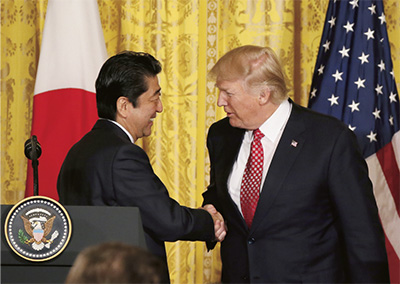 Prime Minister Abe shaking hands with President Trump at the Japan-U.S. Summit Meeting (February 10, 2017, Washington D.C., U.S.; Photo: Cabinet Public Relations Office)
Prime Minister Abe shaking hands with President Trump at the Japan-U.S. Summit Meeting (February 10, 2017, Washington D.C., U.S.; Photo: Cabinet Public Relations Office) Foreign Minister Kishida shaking hands with Secretary of State Tillerson at the Japan-U.S. Foreign Ministers' Meeting (February 10, 2017, Washington D.C., U.S.)
Foreign Minister Kishida shaking hands with Secretary of State Tillerson at the Japan-U.S. Foreign Ministers' Meeting (February 10, 2017, Washington D.C., U.S.)

- 1 On November 17, shortly after the presidential election, Prime Minister Abe stopped off in New York on his way to attend the APEC Economic Leaders' Meeting in Peru, held an unofficial meeting with president-elect Trump, and congratulated him on his victory in the presidential election.
(3) Japan-U.S. Economic Relations
The close cooperation in the economic field between Japan and the U.S., who boast the third and the largest world economies on a GDP basis, is essential not only for revitalizing the economies of both countries, but also for further strengthening the Japan-U.S. Alliance and for the development of the global economy. In recent years, Japan-U.S. economic relations have greatly deepened, as cooperation in various fields, including infrastructure, energy, technology and global issues has progressed and investment in both directions has grown.
Of particular note is the investment by Japanese companies in the U.S. Currently, Japan's cumulative direct investment in the U.S. occupies the position of second highest after the United Kingdom (approximately 411 billion U.S. dollars (2015)). This kind of direct investment is contributing to the regional economy of the U.S. in the form of employment creation by Japanese companies in the U.S. (approximately 840,000 people (2014)), and the strengthening of the multi-layered relationship of the two countries through this kind of vigorous investment and employment creation has become a rock-solid foundation for good Japan-U.S. relations that are better than ever before.
With respect to infrastructure development, the Japan-U.S. Railway Cooperation Meeting, which the two countries agreed to establish when Secretary of Transportation Anthony Foxx visited Japan in 2015, was held for the first time and collaboration between Japan and the U.S. in the railways field was deepened. Regarding the Superconducting Maglev technology that could be introduced to the Northeast Corridor, the U.S. government decided to offer a federal subsidy for the project and, in addition, Japan allocated survey expenses for the project in its FY2016 budget, so both Japan and the U.S. have worked together to advance the project. Regarding the Texas Central Railway Project, a technical support contract was concluded with a local subsidiary of a Japanese company, and in addition when the mayors of Dallas and Fort Worth, Texas, visited Japan, they expressed their expectations for the project. Regarding the California High-Speed Rail Project, the public and private sectors will continue to make appeals for the project, while strengthening cooperation with the U.S., including holding the Japan-U.S. Joint Seminar on Infrastructure in the Philippines using the Quality Infrastructure Investment promoted by Japan.

In the energy area, progress was seen in the areas in which Japan has been making efforts. The ban on crude oil exports was lifted by the FY 2016 omnibus spending bill at the end of 2015, which included the lifting of the ban on crude oil exports, and in May 2016, the import of U.S. produced crude oil was realized for the first time after the lifting of the ban on exports. Furthermore, regarding liquefied natural gas (LNG), the first LNG export base on the U.S. mainland commenced operations in February, and in January 2017 import to Japan was realized. It is expected that these outcomes will make a large contribution to energy security and the stable supply of energy to Japan.
In the technology area, cooperation between Japan and the U.S. is seen in such fields as the digital economy, life sciences, robots, and space technology. The relations between the two countries have also been strengthened for assisting venture companies and creation of innovation. In particular in the digital economy area, Japan and the U.S. have formed a shared recognition regarding basic principles such as “free flow of information” and “multi-stakeholders approaches,” etc. in international fora such as the G7 and G20 and, in addition, Japan and the U.S. have cooperated to lead international discussions about these principles, including incorporating norms regarding cyber theft of trade secrets in the APEC Leaders' Declaration, etc. In addition, Japan and the U.S. are advancing cooperation in global issues, including the environment and climate change, international health, etc. Furthermore, in the 53rd Japan-U.S. Business Conference (November), Minister for Foreign Affairs Fumio Kishida took the stage to boost initiatives to strengthen collaboration between Japan and the U.S. at the private sector level. For example, he appealed to the importance of the Japan-U.S. economic relationship and the contribution to the U.S. economy made by Japanese companies.
Moreover, cooperation is advancing in the local regions. In Washington State and Maryland, memoranda of cooperation were created, and the Memorandum with California was renewed, strengthening relations at the state level. Furthermore, from the perspective that alleviating the burden of obtaining a local driver's license is important in order for people to get their lives organized quickly when settling in the U.S., a Memorandum regarding reciprocal partial exemption of the driver's license examination was created in Maryland in November 2015 and in Washington State in November 2016. As a result of that, the knowledge and skills examination in the driver's license examination implemented by these states are now exempted for applicants possessing a Japanese driver's license.
With regard to the areas of investment and tourism, in conjunction with the 2016 SelectUSA Investment Summit held in June and hosted by the U.S., Japan hosted a reception with the objective of appealing to the direct investment in the U.S. by Japanese companies and their contribution to the U.S. Furthermore, taking the opportunity of the UN General Assembly held in New York in September, Prime Minister Abe gave speeches in dialogue events with persons involved in the financial sector and in the Invest Japan Seminar held by the Japan External Trade Organization (JETRO). At these events, he explained about the value of a TPP agreement contributing to free and fair trade and the outcomes and prospects of improving the environment for investment in Japan under Abenomics and talked about the attractiveness of Japan as an investment destination. Furthermore, the Prime Minister expressed his intention to strengthen nationwide systems for receiving tourists by 2020 at the Visit Japan Tourism Seminar held by the Japan National Tourism Organization (JNTO).
After the signing of the TPP agreement in February 2016, in Japan the bill approving the TPP agreement and the related bills were approved in the Diet. In January 2017 President Trump signed a Presidential Memorandum on the withdrawal from the TPP Agreement; however, Japan and the U.S. have agreed regarding the necessity to create a free and fair economic zone in the Asia-Pacific region led by Japan and the U.S. In the economic dialogue between Japan and the U.S. going forward, in-depth discussions will take place, including on the question of what kind of economic framework would be best for Japan and the U.S. economy.
In September, the Study Group on Japan-US Economy 2016 comprised of knowledgeable persons active in various fields was launched as a forum for discussions regarding the future of Japan-U.S. economic relations and strengthening all aspects of Japan-U.S. relations. The proposal submitted to Foreign Minister Kishida in November by the Study Group proposed the strengthening of cooperation in such areas like infrastructure. The promotion of multilevel dialogue, the need for Japan and the U.S. to exercise leadership towards advancing free trade, and the promotion of a strategic public-private partnership in order to further deepen Japan-U.S. relations. (See Special Feature “Toward Building a New Japan-U.S. Economic Relationship: Submission of Proposals by the Study Group on Japan-US Economy 2016”) In January 2017, President Trump was inaugurated and the government will endeavor to build a new Japan-U.S. economic relationship based on these proposals. Furthermore, in the Japan-U.S. Summit Meeting held on February 10, Japan and the U.S. agreed to establish a framework for new economic dialogue led by Deputy Prime Minister and Finance Minister Aso and Vice President Pence. Going forward, through this new economic dialogue the two countries will discuss (i) economic policies, (ii) cooperation in the areas of infrastructure and energy, etc. and (iii) rules related to trade and investment. They will conduct constructive discussions led by the shared goal of Japan and the U.S.: expanding free and fair markets throughout the world under the leadership of Japan and the U.S.
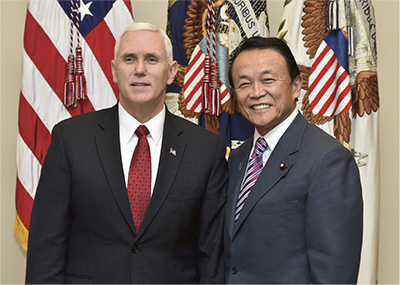 Meeting between Deputy Prime Minister and Minister of Finance Aso and Vice President Pence of the United States of America (February 10, 2017, Washington D.C., U.S.)
Meeting between Deputy Prime Minister and Minister of Finance Aso and Vice President Pence of the United States of America (February 10, 2017, Washington D.C., U.S.)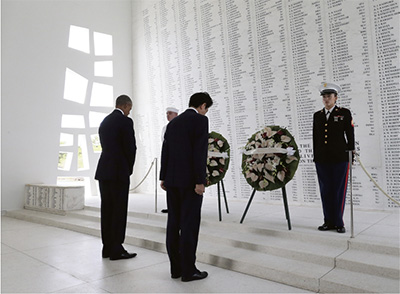 The visit by the leaders of Japan and the U.S. to the USS Arizona Memorial (December 27, Hawaii, U.S.; Photo: Cabinet Public Relations Office)
The visit by the leaders of Japan and the U.S. to the USS Arizona Memorial (December 27, Hawaii, U.S.; Photo: Cabinet Public Relations Office)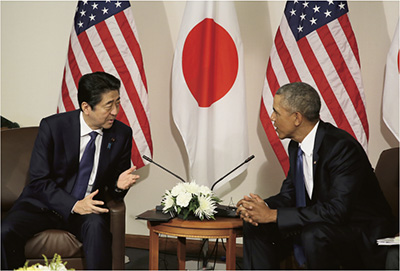 Japan-U.S. Summit Meeting (December 27, Hawaii, U.S.; Photo: Cabinet Public Relations Office)
Japan-U.S. Summit Meeting (December 27, Hawaii, U.S.; Photo: Cabinet Public Relations Office)From December 26 to 27, 2016 Prime Minister Abe visited the Island of Oahu, the State of Hawaii, the United States of America.
On December 26 Prime Minister Abe, accompanied by Foreign Minister Kishida, Minister for Defense Inada and others, visited the National Memorial Cemetery of the Pacific, the Japanese Section of Makiki Cemetery, the Ehime Maru Memorial and the Memorial for Commander Fusata Iida, and at each location he laid a wreath and offered a silent prayer. Furthermore, Prime Minister Abe visited the Central Identification Laboratory (CIL) of the United States Defense POW/MIA Accounting Agency (DPAA), the Department of Defense, and observed the remains stored within the CIL as well as the examination work for the accounting process. That night, Prime Minister Abe participated in a dinner banquet with approximately 1,000 people, including representatives of organizations for people of Japanese descent living in Hawaii, and government officials from the State of Hawaii. In his speech, he expressed his gratitude once again to the Japanese-Americans for their significant contributions to the Japan-U.S. relationship, and stated the importance of the further development of the special Japan-Hawaii and Japan-U.S. relations.
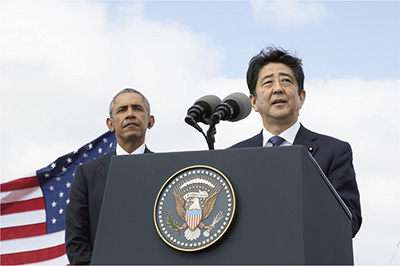 The statements by the leaders of Japan and the U.S. (December 27, Hawaii, U.S.; Photo: Cabinet Public Relations Office)
The statements by the leaders of Japan and the U.S. (December 27, Hawaii, U.S.; Photo: Cabinet Public Relations Office)On December 27 Prime Minister Abe visited the Pearl Harbor Visitor Center, and after that he held a Japan-U.S. Summit Meeting with President Obama. The two leaders confirmed that the value and significance of the “Alliance of Hope” would not change going forward, and shared the recognition that it is important to further strengthen the Japan-U.S. Alliance in the future, so it was a valuable meeting that was suitable as a culmination of the past four years.
After that, Prime Minister Abe visited the USS Arizona Memorial in Pearl Harbor with President Obama, and both leaders laid wreaths, and offered silent prayers, facing the marble wall on which the names of perished USS Arizona crewmembers are engraved, and offered prayers at the Ceremonial Well above the sunken USS Arizona. Moreover, the two leaders gave statements at the pier. Prime Minister Abe extended his sincere condolences to the victims of the attack on Pearl Harbor and all other victims of the past wars. The Prime Minister pledged his unwavering vow never to repeat the horrors of war and demonstrated strongly the power of reconciliation. Following this, President Obama stated that the Japan-U.S. Alliance is “a reminder that even the deepest wounds of war can give way to friendship and lasting peace.” The President also said as follows: “The most bitter of adversaries can become the strongest of allies. The fruits of peace always outweigh the plunder of war. This is the enduring truth of this hallowed harbor.”
This visit to Hawaii by Prime Minister Abe renews Japan's unwavering vow to the future never to repeat the horrors of war, and demonstrated to the world the power of the reconciliation of Japan and the U.S., two countries that formerly fought as enemies but after the war transformed into allies with shared values.
President Obama, Commander Harris, ladies and gentlemen, and all American citizens,
I stand here at Pearl Harbor as the prime minister of Japan.
If we listen closely we can make out the sound of restless waves, breaking and then retreating again. The calm inlet of brilliant blue is radiant with the gentle sparkle of the warm sun.
Behind me, a striking white form atop the azure, is the USS Arizona Memorial.
Together with President Obama, I paid a visit to that memorial, the resting place for many souls.
It was a place which brought utter silence to me.
Inscribed there are the names of the servicemen who lost their lives.
Sailors and marines hailing from California and New York, Michigan and Texas, and various other places, serving to uphold their noble duty of protecting the homeland they loved, lost their lives amidst searing flames that day, when aerial bombing tore the USS Arizona in two.
Even 75 years later, the USS Arizona, now at rest atop the seabed, is the final resting place for a tremendous number of sailors and marines.
Listening again as I focus my senses, alongside the song of the breeze and the rumble of the rolling waves, I can almost discern the voices of those crewmen.
Voices of lively conversations, upbeat and at ease, on that day, on a Sunday morning.
Voices of young servicemen talking to each other about their futures and dreams.
Voices calling out the names of loved ones in their very final moments.
Voices praying for the happiness of children still unborn.
Each and every one of those servicemen had a mother and a father anxious about his safety.
Many had wives and girlfriends they loved. And many must have had children they would have loved to watch grow up.
All of that was brought to an end. When I contemplate that solemn reality, I am rendered entirely speechless.
“Rest in peace, precious souls of the fallen.” With that overwhelming sentiment, I cast flowers on behalf of Japanese people, upon the waters where those sailors and marines sleep.
* * *
President Obama, the people of the United States of America, and the people around the world,
As the prime minister of Japan, I offer my sincere and everlasting condolences to the souls of those who lost their lives here, as well as to the spirits of all the brave men and women whose lives were taken by a war that commenced in this very place, and also to the souls of the countless innocent people who became victims of the war.
We must never repeat the horrors of war again.
This is the solemn vow we, the people of Japan, have taken. And since the war, we have created a free and democratic country that values the rule of law and has resolutely upheld our vow never again to wage war.
We, the people of Japan, will continue to uphold this unwavering principle, while harboring quiet pride in the path we have walked as a peace-loving nation over these 70 years since the war ended.
To the souls of the servicemen who lie in eternal rest aboard the USS Arizona, to the American people, and to all peoples around the world, I pledge that unwavering vow here as the prime minister of Japan.
* * *
Yesterday, at the Marine Corps Base Hawaii in Kaneohe Bay, I visited the memorial marker for an Imperial Japanese Navy officer.
He was a fighter pilot by the name of Commander Fusata Iida who was hit during the attack on Pearl Harbor and gave up on returning to his aircraft carrier. He went back instead and died.
It was not Japanese who erected a marker at the site that Iida's fighter plane crashed. It was U.S. servicemen who had been on the receiving end of his attack.
Applauding the bravery of the dead pilot, they erected this stone marker.
On the marker, his rank at that time is inscribed, “Lieutenant, Imperial Japanese Navy,” showing their respect toward a serviceman who gave his life for his country.
“The brave respect the brave.”
So wrote Ambrose Bierce in a famous poem.
Showing respect even to an enemy they fought against; trying to understand even an enemy that they hated --- therein lies the spirit of tolerance embraced by the American people.
When the war ended and Japan was a nation in burnt-out ruins as far as the eye could see, suffering under abject poverty, it was the United States, and its good people, that unstintingly sent us food to eat and clothes to wear.
The Japanese people managed to survive and make their way toward the future thanks to the sweaters and milk sent by the American people.
And it was the United States that opened up the path for Japan to return to the international community once more after the war.
Under the leadership of the United States, Japan, as a member of the free world, was able to enjoy peace and prosperity.
The goodwill and assistance you extended to us Japanese, the enemy you had fought so fiercely, together with the tremendous spirit of tolerance were etched deeply into the hearts and minds of our grandfathers and mothers.
We also remember them. Our children and grandchildren will also continue to pass these memories down and never forget what you did for us.
The words pass through my mind; those words inscribed on the wall at the Lincoln Memorial in Washington D.C. where I visited with President Obama.
“With malice toward none, with charity for all… let us strive on… to do all which may achieve and cherish a… lasting peace among ourselves and with all nations.”
These are the words of President Abraham Lincoln.
On behalf of the Japanese people, I hereby wish to express once again my heartfelt gratitude to the United States and to the world for the tolerance extended to Japan.
* * *
It has now been 75 years since that “Pearl Harbor.” Japan and the United States, which fought a fierce war that will go down in the annals of human history, have become allies with deep and strong ties rarely found anywhere in history.
We are allies that will tackle together, to an even greater degree than ever before, the many challenges covering the globe.
Ours is an “alliance of hope” that will lead us to the future.
What has bonded us together is the power of reconciliation, made possible through the spirit of tolerance.
What I want to appeal to the people of the world, here at Pearl Harbor, together with President Obama, is this power of reconciliation.
Even today, the horrors of war have not been eradicated from the surface of the world. There is no end to the spiral where hatred creates hatred.
The world needs the spirit of tolerance and the power of reconciliation now -- and especially now.
Japan and the United States, which have eradicated hatred and cultivated friendship and trust on the basis of common values, are now, and especially now, taking responsibility for appealing to the world about the importance of tolerance and the power of reconciliation.
That is precisely why the Japan-U.S. alliance is “an alliance of hope.”
* * *
The inlet gazing at us is tranquil as far as the eye can see.
Pearl Harbor.
It is precisely this beautiful inlet, shimmering like pearls, that is a symbol of tolerance and reconciliation.
It is my wish that our Japanese children, and President Obama, your American children, and indeed their children and grandchildren, and people all around the world, will continue to remember Pearl Harbor as the symbol of reconciliation.
We will spare no efforts to continue our endeavors to make that wish a reality. Together with President Obama, I hereby make my steadfast pledge.
Thank you very much.
Provisional translation: Prime Minister of Japan and His Cabinet
PRESIDENT OBAMA: Prime Minister Abe, on behalf of the American people, thank you for your gracious words. Thank you for your presence here today -- an historic gesture that speaks to the power of reconciliation and the alliance between the American and Japanese peoples; a reminder that even the deepest wounds of war can give way to friendship and lasting peace.
Distinguished guests, members of our armed forces -- and most of all, survivors of Pearl Harbor and their loved ones -- aloha.
AUDIENCE: Aloha.
PRESIDENT OBAMA: To Americans -- especially to those of us who call Hawaii home -- this harbor is a sacred place. As we lay a wreath or toss flowers into waters that still weep, we think of the more than 2,400 American patriots -- fathers and husbands, wives and daughters -- manning Heaven's rails for all eternity. We salute the defenders of Oahu who pull themselves a little straighter every December 7th, and we reflect on the heroism that shone here 75 years ago.
As dawn broke that December day, paradise never seemed so sweet. The water was warm and impossibly blue. Sailors ate in the mess hall, or readied themselves for church, dressed in crisp white shorts and t-shirts. In the harbor, ships at anchor floated in neat rows: the California, the Maryland and the Oklahoma, the Tennessee, the West Virginia and the Nevada. On the deck of the Arizona, the Navy band was tuning up.
That morning, the ranks on men's shoulders defined them less than the courage in their hearts. Across the island, Americans defended themselves however they could -- firing training shells, working old bolt-action rifles. An African-American mess steward, who would typically be confined to cleaning duties, carried his commander to safety, and then fired an anti-aircraft gun until he ran out of ammo.
We honor Americans like Jim Downing -- a gunner's mate first class on the West Virginia. Before he raced to the harbor, his new bride pressed into his hand a verse of Scripture: “The eternal God is thy refuge, and underneath are the everlasting arms.” As Jim fought to save his ship, he simultaneously gathered the names of the fallen so that he could give closure to their families. He said, “It was just something you do.”
We remember Americans like Harry Pang -- a fireman from Honolulu who, in the face of withering fire, worked to douse burning planes until he gave his last full measure of devotion
-- one of the only civilian firefighters ever to receive the Purple Heart.
We salute Americans like Chief Petty Officer John Finn, who manned a .50-caliber machine gun for more than two hours and was wounded more than 20 times, earning him our nation's highest military decoration, the Medal of Honor.
And it is here that we reflect on how war tests our most enduring values -- how, even as Japanese Americans were deprived of their own liberty during the war, one of the most decorated military units in the history of the United States was the 442nd Infantry Regiment and its 100th Infantry Battalion -- the Japanese-American Nisei. In that 442nd served my friend and proud Hawaiian, Daniel Inouye -- a man who was a senator from Hawaii for most of my life and with whom I would find myself proud to serve in the Senate chamber; a man who was not only a recipient of the Medal of Honor and the Presidential Medal of Freedom, but was one of the most distinguished statesmen of his generation as well.
Here at Pearl Harbor, America's first battle of the Second World War roused a nation. Here, in so many ways, America came of age. A generation of Americans -- including my grandparents -- the Greatest Generation -- they did not seek war, but they refused to shrink from it. And they all did their part on fronts and in factories. And while, 75 years later, the proud ranks of Pearl Harbor survivors have thinned with time, the bravery we recall here is forever etched in our national heart. I would ask all our Pearl Harbor and World War II veterans who are able to, to please stand or raise your hands -- because a grateful nation thanks you. (Applause.)
The character of nations is tested in war, but it is defined in peace. After one of the most horrific chapters in human history -- one that took not tens of thousands, but tens of millions of lives -- with ferocious fighting across this ocean -- the United States and Japan chose friendship and peace. Over the decades, our alliance has made both of our nations more successful. It has helped underwrite an international order that has prevented another World War and that has lifted more than a billion people out of extreme poverty. And today, the alliance between the United States and Japan -- bound not only by shared interests, but also rooted in common values -- stands as the cornerstone of peace and stability in the Asia Pacific and a force for progress around the globe. Our alliance has never been stronger.
In good times and in bad, we are there for each other. Recall five years ago, when a wall of water bore down on Japan and reactors in Fukushima melted, America's men and women in uniform were there to help our Japanese friends. Across the globe, the United States and Japan work shoulder-to-shoulder to strengthen the security of the Asia Pacific and the world -- turning back piracy, combating disease, slowing the spread of nuclear weapons, keeping the peace in war-torn lands.
Earlier this year, near Pearl Harbor, Japan joined with two dozen nations in the world's largest maritime military exercise. That included our forces from U.S. Pacific Command, led by Admiral Harry Harris, the son of an American Naval officer and a Japanese mother. Harry was born in Yokosuka, but you wouldn't know it from his Tennessee twang. (Laughter.)
Thank you, Harry, for your outstanding leadership. (Applause.)
In this sense, our presence here today -- the connections not just between our governments, but between our people, the presence of Prime Minister Abe here today -- remind us of what is possible between nations and between peoples. Wars can end. The most bitter of adversaries can become the strongest of allies. The fruits of peace always outweigh the plunder of war. This is the enduring truth of this hallowed harbor.
It is here that we remember that even when hatred burns hottest, even when the tug of tribalism is at its most primal, we must resist the urge to turn inward. We must resist the urge to demonize those who are different. The sacrifice made here, the anguish of war, reminds us to seek the divine spark that is common to all humanity. It insists that we strive to be what our Japanese friends call otagai no tame ni -- “with and for each other.”
That's the lesson of Captain William Callaghan of the Missouri. Even after an attack on his ship, he ordered that the Japanese pilot be laid to rest with military honors, wrapped in a Japanese flag sewn by American sailors. It's the lesson, in turn, of the Japanese pilot who, years later, returned to this harbor, befriended an old Marine bugler and asked him to play taps and lay two roses at this memorial every month -- one for America's fallen and one for Japan's.
It's a lesson our two peoples learn every day, in the most ordinary of ways -- whether it's Americans studying in Tokyo, young Japanese studying across America; scientists from our two nations together unraveling the mysteries of cancer, or combating climate change, exploring the stars. It's a baseball player like Ichiro lighting up a stadium in Miami, buoyed by the shared pride of two peoples, both American and Japanese, united in peace and friendship.
As nations, and as people, we cannot choose the history that we inherit. But we can choose what lessons to draw from it, and use those lessons to chart our own futures.
Prime Minister Abe, I welcome you here in the spirit of friendship, as the people of Japan have always welcomed me. I hope that together, we send a message to the world that there is more to be won in peace than in war; that reconciliation carries more rewards than retribution.
Here in this quiet harbor, we honor those we lost, and we give thanks for all that our two nations have won -- together, as friends.
May God hold the fallen in His everlasting arms. May He watch over our veterans and all who stand guard on our behalf. May God bless us all.
Thank you. (Applause.)
The original text: The White House
1 About the Study Group on Japan-U.S. Economy 2016
In September 2016, the Study Group on Japan-U.S. Economy 2016 was established as a forum for holding discussions with knowledgeable persons about what the path forward of the Japan-U.S. economic relationship should be and methods of further strengthening all aspects of Japan-U.S. relations in anticipation of the incoming U.S. administration. In the Study Group, the 12 members from various backgrounds held intensive discussions a total of five times from September to November.
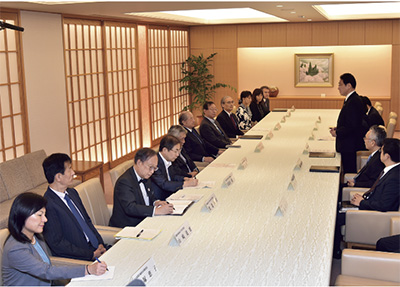 Exchange of views between the members of the Study Group on Japan-U.S. Economy 2016 and Foreign Minister Kishida (September 13, Tokyo)
Exchange of views between the members of the Study Group on Japan-U.S. Economy 2016 and Foreign Minister Kishida (September 13, Tokyo)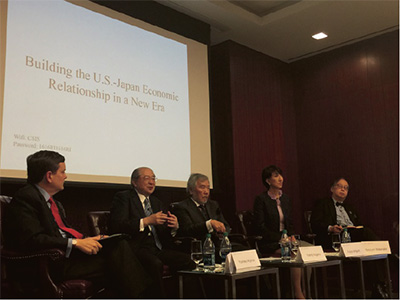 Discussions regarding the proposal by the members of the Study Group on Japan-U.S. Economy 2016 (December 5, Washington D.C., U.S.)
Discussions regarding the proposal by the members of the Study Group on Japan-U.S. Economy 2016 (December 5, Washington D.C., U.S.)2 The four pillars
The Study Group compiled the following four pillars in order to further deepen Japan-U.S. economic relations taking into account the situation of the world economy.
Pillar I: The Need for Further Promotion and Deepening of the Japan-U.S. Economic Relationship and for Promotion of Cooperation Based on This Relationship ([As areas in which cooperation should be promoted,] infrastructure, cutting-edge technologies, and energy have been suggested.)
Pillar II: The Need to Promote Multilevel Dialogue That Is in Line With the Japan-U.S. Cooperation in a New Era
Pillar III: The Need to Exercise Japan-U.S. Leadership towards Advancing Free Trade
Pillar IV: The Need to Advance a Strategic Public-Private Partnership
In November Foreign Minister Kishida gave a lecture entitled “The Japan-U.S. Economic Relationship in a New Era” to world financial market professionals. In the lecture Foreign Minister Kishida, taking into account the pillars proposed from the Study Group, declared his determination to make every effort in his position as foreign minister to build a “Japan-U.S. Economic Relationship in a New Era” through which the two countries can play a responsible role in the world economy.
Furthermore, in December, the members of the Study Group visited Washington DC and participated in an event to announce their proposal at the Center for Strategic and International Studies (CSIS), and in addition they held an exchange of views regarding the proposal, etc. with local knowledgeable persons.
3 Toward new Japan-U.S. economic relations
President Trump, who was elected as the next president in November, also places importance on the infrastructure and energy areas indicated in the proposal, so such areas can become promising business opportunities for both Japan and the U.S. Japan will cooperate and work closely with the new U.S. administration toward building new Japan-U.S. economic relations based on the proposal of the Study Group, in order to further deepen Japan-U.S. economic relations in a variety of areas, including the infrastructure and energy areas.




